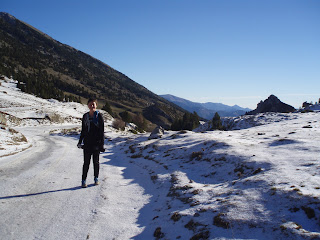IV Marató Pirata de Montserrat
It was getting to the end of our trip, but we still had at least one adventure to come. Xavier, a Catalan runner I'd been put in touch with for information about the Camí dels Bons Homes, had mentioned that his running team was organizing a "pirate marathon" (a free, loosely-organized, non-race event) at Montserrat, a mountain about 45 minutes northwest of Barcelona, for the day before our flight left. He kindly invited us to join, and Divesh, Carles, and I decided that sounded like a pretty good idea.
Xavier's team are called the Koalas, apparently named after the founder being told that he ran like a koala. This meant it was an appropriate event for Divesh, who has been told that he climbs like a drunk koala.
The Koalas and their friends are good at running, but also at putting on parties, eating, and drinking. About 30 runners, including us, met up in a restaurant on Friday night around 10pm for dinner and drinks. The friendliness and enthusiasm in the room was incredibly impressive. The group reminded me of our little network of Midwestern runners, only with more decibels and a significantly more relaxed approach to sleeping and hydrating. While many runners stayed up all night and then went straight out for the marathon, Carles and Divesh and I were in the group of weaklings who retreated to a hotel around 1 am for a few hours of sleep.
The idea for the marathon was to have lots of differently-paced groups start at different times, with the slowest starting first, then the next-fastest, etc., so that everyone would end around the same time. This was key, because there was an impressive after-run lunch that nobody would want to miss. Carles and Divesh and I went with one of the middle groups, which started at 5 a.m. and was supposed to take 8 hours to finish. The description of the pace said it would involve plenty of walking and photo stops, so I figured that no matter how hard the mountain trails were, 8 hours to finish a marathon was plenty...
Our group met up at the start just before 5 a.m., got a course briefing (unless my Catalan failed me, the main navigational message was "Don't get lost. If you get lost, you're doomed.") and set off. What followed was some of the most crazy, but also most fun, 8.5 hours of running I've ever done. Each group had a couple of guides who knew where they were going, but the rest of us had no clue, so everyone, which was about 30 people, had to stay together. This meant a frantic, headless-chicken type scramble not to get behind, which was a little tricky when we unexpectedly set off at 8 minute miles in the dark.
The first trip up the mountain was a bit of a shock. It went on for miles, on steep, technical ground. It was now all too evident why it was going to take us 8 hours to finish this thing. Fortunately, once it started getting light, the views provided plenty of distraction from the hard work.
As good as the views were, the people were even better. Your legs can only hurt so much when you're surrounded by such nice people.
 |
| Photo from Senglar's team |
And my legs did hurt. The headless-chicken style of run continued for pretty much the entire time, especially when the guys in the photo above (who I was not about to lose, since they knew where they were going) took off like they were running a 10k... this was one fast bunch of runners!
This is where I unfortunately have to give some bad news to Minnesota runners. We may pride ourselves on how great our aid stations are, but we are in fact being seriously outdone by the Catalans. Exhibit A:
This is a sample of aid station food, including fresh baguettes, spread with high-quality olive oil, and various types of Spanish ham. What I unfortunately didn't manage to capture in this shot is the pot of chocolate fondue with fruit for dipping. Or the beer.
Exhibit B is the next aid station. When we got there, there was a long line leading to a table. We couldn't figure out what the line was for--water? Coke? No, of course not. It was for face-painting, rum, mini golf, and hopscotch. Because what else would you have at mile 22?
After this aid station, it was "just" one brutal trip up and down the mountain again, and we were home. We were met with food, more beer, and a group trip to a buffet. I don't think the buffet owners knew what hit them when 100 runners, who had just been out running up and down a mountain for 6 to 12 hours, descended on their restaurant!
I was telling Xavier on Friday night that with all the great people in both of our respective running groups (the Minnesota/honorary Minnesotan runners, and the Barcelona-area runners), it would be great to do a runner exchange, with some runners from here going to one of their races and vice versa. Keep this in mind and I'll post more about future developments!







.jpg)




.jpg)






































